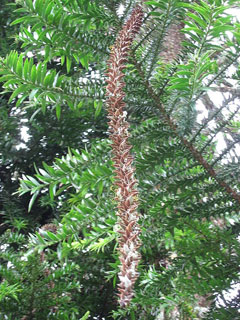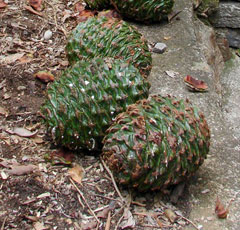 |
|
http://commons.wikimedia.org/wiki/User:Liné1 |
 |
| http://www.flickr.com/photos/tgerus/ |
Translate this page:
Summary
Form: Columnar, Pyramidal.
Physical Characteristics

 Araucaria_bidwillii is an evergreen Tree growing to 40 m (131ft 3in) at a medium rate.
Araucaria_bidwillii is an evergreen Tree growing to 40 m (131ft 3in) at a medium rate.
See above for USDA hardiness. It is hardy to UK zone 9. It is in leaf all year, in flower in June, and the seeds ripen from September to October. The species is monoecious (individual flowers are either male or female, but both sexes can be found on the same plant) and is pollinated by Wind.
Suitable for: light (sandy), medium (loamy) and heavy (clay) soils and prefers well-drained soil. Suitable pH: mildly acid, neutral and basic (mildly alkaline) soils. It can grow in semi-shade (light woodland) or no shade. It prefers moist soil.
UK Hardiness Map
US Hardiness Map
Synonyms
Plant Habitats
Edible Uses
Seed - raw, cooked or ground into a powder[1, 2, 81, 157, 183]. Starchy and delicious, it has the texture of a waxy boiled potato with the flavour of chestnuts[183]. Large, it is an important food source for the Australian Aborigines[156]. Cones can be up to 4.5 kilos in weight and contain up to 150 seeds[1]. The germinating seed produces an underground 'earth nut' which has a coconut-like flavour[183].
References More on Edible Uses
Medicinal Uses
Plants For A Future can not take any responsibility for any adverse effects from the use of plants. Always seek advice from a professional before using a plant medicinally.
None known
References More on Medicinal Uses
The Bookshop: Edible Plant Books
Our Latest books on Perennial Plants For Food Forests and Permaculture Gardens in paperback or digital formats.

Edible Tropical Plants
Food Forest Plants for Hotter Conditions: 250+ Plants For Tropical Food Forests & Permaculture Gardens.
More

Edible Temperate Plants
Plants for Your Food Forest: 500 Plants for Temperate Food Forests & Permaculture Gardens.
More

More Books
PFAF have eight books available in paperback and digital formats. Browse the shop for more information.
Shop Now
Other Uses
Wood - soft, easily worked, high quality. Used for cabinet making, flooring, plywood etc[156]. The branches are used for fencing and fuel[272].
Special Uses
References More on Other Uses
Cultivation details
Landscape Uses:Container, Pest tolerant, Aggressive surface roots possible, Specimen. Succeeds in most soils[157]. Plants are resistant to salt spray[157]. Not very hardy outdoors in Britain, it requires a cool greenhouse in most parts of the country[1]. Some provenances should be hardy at least in the milder areas, there is one tree growing in Cornwall at Glendurgan gardens[81]. It was 10 metres tall in 1965[185]. This species is hardy to about -5°c, with occasional lows to -8°c, but it is liable to be killed in severe winters even in the Scilly Isles[200]. In Australia, each Aboriginal family would own a group of trees and these would be passed down from generation to generation[2]. This is said to be the only case of hereditary personal property owned by the Aborigines[2]. Special features:Not North American native, Inconspicuous flowers or blooms.
References Carbon Farming Information and Carbon Sequestration Information
Temperature Converter
Type a value in the Celsius field to convert the value to Fahrenheit:
Fahrenheit:
The PFAF Bookshop
Plants For A Future have a number of books available in paperback and digital form. Book titles include Edible Plants, Edible Perennials, Edible Trees,Edible Shrubs, Woodland Gardening, and Temperate Food Forest Plants. Our new book is Food Forest Plants For Hotter Conditions (Tropical and Sub-Tropical).
Shop Now
Plant Propagation
Seed - best sown as soon as it is ripe in a greenhouse[134] or it can be stored cool and moist then sown February in a greenhouse[78, 80]. The seed usually germinates in 1 - 2 months at 15°c[134]. As soon as they are large enough to handle, prick the seedlings out into individual pots. The plants have a rather sparse root system and are best placed in their final positions as soon as possible. Give them some protection from the cold for at least their first winter[K].
Other Names
If available other names are mentioned here
Native Range
AUSTRALASIA: Australia (Queensland (east))
Weed Potential
Right plant wrong place. We are currently updating this section.
Please note that a plant may be invasive in one area but may not in your area so it’s worth checking.
Conservation Status
IUCN Red List of Threatened Plants Status :

Growth: S = slow M = medium F = fast. Soil: L = light (sandy) M = medium H = heavy (clay). pH: A = acid N = neutral B = basic (alkaline). Shade: F = full shade S = semi-shade N = no shade. Moisture: D = dry M = Moist We = wet Wa = water.
Expert comment
Author
Hook.
Botanical References
81200
Links / References
For a list of references used on this page please go here
Readers comment